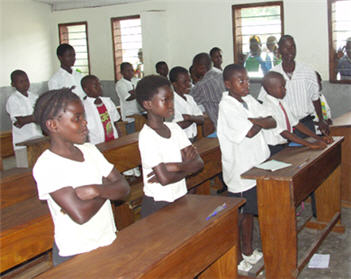
The Democratic Republic of Congo (DRC) has made significant progress in education and child survival in recent years, but much more needs to be done to achieve the anti-poverty Millennium Development Goals (MDGs), according to a new United Nations-backed study.
Three out of four children now go to school, a 23 per cent increase over 2000 with near parity for girls and boys, the fourth Multiple Indicator Cluster Survey (UNICEF), reported.
“This study shows that we have made significant progress over the last decade,” UNICEF Representative Pierrette Vu Thi said of the latest MICS, which covers topics including but not limited to demography, health, nutrition, education, water and sanitation, and socio-economic indicators.
“We must continue our efforts with vigour to reach every child in this country, which is nearly as vast as Western Europe,” she added.
The latest UN report on global child mortality shows that worldwide mortality rates among children below five years old are the highest in sub-Saharan Africa, where one in eight children dies before his or her fifth birthday. In DRC, 158 out of every 1,000 children die before their fifth birthday, and although this is still very high it shows a positive trend compared to 2001 when the figure was 205 out of every 1,000.
Among the worrying tendencies are the degradation of birth registration and stagnation in the use of improved drinking water sources and better sanitation. Still only one in seven people in DRC lives in acceptable hygienic conditions and less than half of the population has access to safe drinking water.
Two out of three children under five do not have a birth certificate, a situation that has worsened over the past decade. While 34 per cent were registered in 2000, the figure has now dropped to 28 per cent.
“This survey is shedding light on the situation of children and women in DRC today,” Planning Minister Olivier Kamitatu Etsu said. “It will help to plan interventions that are crucial to achieve the Millennium Development Goals,” he added, referring to the UN targets that seek to slash extreme poverty and hunger, disease, maternal and infant mortality, and lack of access to education and health services, all by 2015.
Under the leadership of the Ministry of Planning, the MICS was conducted by the National Institute of Statistics with technical and financial support from UNICEF and contributions from the UN World Food Programme (WFP), the UN Population Fund (UNFPA) and United States Agency for International Development (USAID).
It found overall inequalities in the DRC, with indicators worst for the most vulnerable and hard-to-reach women and children. For every four fully vaccinated children in socio-economically well-off families, there is just one such child in disadvantaged households. The same was found for literacy: there are four times as many literate women in wealthy families as those in disadvantaged ones.
The most vulnerable must become a top priority in order to bridge this gap and achieve the MDGs with equity, said UNICEF. “There is no time to waste.”
Between February and April 350 fieldworkers in 84 teams visited more than 11,000 households across the vast country’s 11 provinces and its city-province and capital Kinshasa. Despite insecurity, lack of roads and temperatures hovering around 45 degrees Celsius, they visited village after village, where families responded patiently to their questions, inspired by the hope for a better future for their children, UNICEF reported.
Related articles
- • 'Deadly environment' plus 'political and social' obstacles hinder Ebola fight, Security Council hears (July 24, 2019)
- • Ebola outbreak declared an international Public Health Emergency (July 17, 2019)
- • DR Congo: The country that knows how to beat Ebola (December 11, 2014)
- • Ebola Epidemic Resurfaces in DR Congo's Equateur Province (August 25, 2014)
- • DR Congo Economic Growth Set to Reach An Unprecedented Seven Percent in 2013 (April 12, 2012)
- • Tshisekedi's Mental Health Called into Question after Incoherent Statements (November 8, 2011)
- • Kabila Makes Re-Election Pitch in Speech to the Nation (September 15, 2011)
- • UN high-level HIV-AIDS meeting continues with progress reports (June 9, 2011)
- • Rape study 'questionable' (May 18, 2011)
- • 2010 Human Development Report analyses long-term development trends (November 4, 2010)
- • President Kabila Pays Respects to Sange Victims (July 5, 2010)
- • Pope urges end to war, education of youth in Congo (April 29, 2010)
- • Joseph Kabila Reshuffles Government (February 21, 2010)
- • Goma: MONUC's hospital provides essential support to the mission and the FARDC (November 18, 2009)
- • President Jacob Zuma to Co-Chair the 6th SA-DRC Bi-National Summit in Pretoria (October 30, 2009)
- • Member States elect 31 countries to join UNESCO's governing body (October 14, 2009)
- • UN Report Describes 'Terrible' Year for Children in Armed Conflict (September 16, 2009)
- • WHO: DR Congo has no influenza A/H1N1 (May 28, 2009)
- • UNICEF: Grave violations of children's rights during armed conflicts must end (April 30, 2009)
- • Celebrities Promote Humanitarian Causes (April 20, 2009)
- • End of Ebola outbreak (February 17, 2009)
- • Fight against malaria continues in the DRC (April 25, 2008)
- • Kinshasa: DRC public health workshop to pave way for the future (April 9, 2008)
- • Government announces end of Ebola outbreak (November 20, 2007)
- • Monitoring of Ebola "must continue" (October 3, 2007)
- • Ebola in DRC: Nearing control of the outbreak, but vigilance still required (October 1, 2007)
- • Medics Struggle to Limit DRC Ebola Outbreak (September 21, 2007)
- • Ebola virus outbreak in central DR Congo claims 160 lives (September 12, 2007)
- • Outbreak in Kasai Occidental confirmed as Ebola (September 11, 2007)
- • Another rebel group gives up arms (February 28, 2007)
Tags: |







